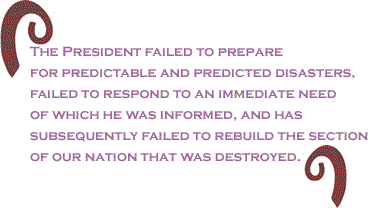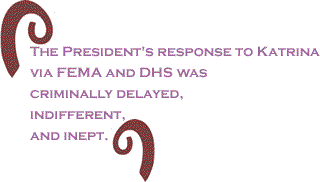
|
||||||||||||||||||||||
 |
||||||||||||||||||||||
 |
||||||||||||||||||||||
 |
||||||||||||||||||||||
 |
||||||||||||||||||||||
 |
||||||||||||||||||||||
 |
||||||||||||||||||||||
 |
| The current issue is always free to everyone |
|
|
 |
| Click here to read full text of all 35 articles of impeachment in PDF format. Click here to view complete video of Kucinich presenting articles of impeachment. In the back of your head have you ever thought that abandoning an American city and nearby towns to a predictable and predicted natural disaster, and then refusing to repair the damage, ought to be considered unacceptable behavior. On a grander scale, does it strike you that there is something seriously wrong with the Bush Administration's failure, not just to acknowledge global warming, but to take significant action to stop increasing it and begin reducing it? If we destroy our home will it matter that there wasn't a specific statute on the books banning the exacerbation of global warming? For a refreshing view of Hurricane Katrina and of global climate change, I highly recommend the following two articles of impeachment, introduced in the House of Representatives on Monday evening by Congressman Dennis Kucinich. Article XXXI KATRINA: FAILURE TO PLAN FOR THE PREDICTED DISASTER OF HURRICANE KATRINA, FAILURE TO RESPOND TO A CIVIL EMERGENCY
Hurricane Katrina killed at least 1,282 people, with 2 million more displaced. 302,000 housing units were destroyed or damaged by the hurricane, 71% of these were low-income units. More than 500 sewage plants were destroyed, more than 170 point-source leakages of gasoline, oil, or natural gas, more than 2000 gas stations submerged, several chemical plants, 8 oil refineries, and a superfund site was submerged. 8 million gallons of oil were spilled. Toxic materials seeped into floodwaters and spread through much of the city and surrounding areas. The predictable increased strength of hurricanes such as Katrina has been identified by scientists for years, and yet the Bush Administration has denied this science and restricted such information from official reports, publications, and the National Oceanic and Atmospheric Agency's website. Donald Kennedy, editor-in-chief of Science, wrote in 2006 that "hurricane intensity has increased with oceanic surface temperatures over the past 30 years. The physics of hurricane intensity growth … has clarified and explained the thermodynamic basis for these observations. [Kerry] Emanuel has tested this relationship and presented convincing evidence." FEMA's
2001 list of the top three most likely and most devastating
disasters were a San Francisco earthquake, a terrorist attack
on New York, and a Category 4 hurricane hitting New Orleans,
with New Orleans being the number one item on that list. FEMA
conducted a five-day hurricane simulation exercise in 2004,
"Hurricane Pam,"
The President was given multiple warnings that Hurricane Katrina had a high likelihood of causing serious damage to New Orleans and the Gulf Coast. At 10 AM on Sunday 28 August 2005, the day before the storm hit, the National Weather Service published an alert titled "DEVASTATING DAMAGE EXPECTED." Printed in all capital letters, the alert stated that "MOST OF THE AREA WILL BE UNINHABITABLE FOR WEEKS...PERHAPS LONGER. AT LEAST ONE HALF OF WELL CONSTRUCTED HOMES WILL HAVE ROOF AND WALL FAILURE. … POWER OUTAGES WILL LAST FOR WEEKS. … WATER SHORTAGES WILL MAKE HUMAN SUFFERING INCREDIBLE BY MODERN STANDARDS."
The President's response to Katrina via FEMA and DHS was criminally delayed, indifferent, and inept. The only FEMA employee posted in New Orleans in the immediate aftermath of Hurricane Katrina, Marty Bahamonde, emailed head of FEMA Michael Brown from his Blackberry device on August 31, 2005 regarding the conditions The email was urgent and detailed and indicated that "The situation is past critical…Estimates are many will die within hours." Brown's reply was emblematic of the administration's entire response to the catastrophe: "Thanks for the update. Anything specific I need to do or tweak?" The Secretary of Homeland Security, Michael Chertoff, did not declare an emergency, did not mobilize the federal resources, and seemed to not even know what was happening on the ground until reporters told him. On Friday August 26, 2005, Governor Kathleen Blanco declared a State of Emergency in Louisiana and Governor Haley Barbour of Mississippi followed suit the next day. Also on that Saturday, Governor Blanco asked the President to declare a Federal State of Emergency, and on 28 August 2005, the Sunday before the storm hit, Mayor Nagin declared a State of Emergency in New Orleans. This shows that the local authorities, responding to federal warnings, knew how bad the destruction was going to be and anticipated being overwhelmed. Failure to act under these circumstances demonstrates gross negligence. In all of these actions and decisions, President George W. Bush has acted in a manner contrary to his trust as President, and subversive of constitutional government, to the prejudice of the cause of law and justice and to the manifest injury of the people of the United States. Wherefore, President George W. Bush, by such conduct, is guilty of an impeachable offense warranting removal from office. ARTICLE XXXII MISLEADING CONGRESS AND THE AMERICAN PEOPLE, SYSTEMATICALLY UNDERMINING EFFORTS TO ADDRESS GLOBAL CLIMATE CHANGE. In his conduct while President of the United States, George W. Bush, in violation of his constitutional oath to faithfully execute the office of President of the United States and, to the best of his ability, preserve, protect, and defend the Constitution of the United States, and in violation of his constitutional duty under Article II, Section 3 of the Constitution "to take care that the laws be faithfully executed", has both personally and acting through his agents and subordinates, together with the Vice President, ignored the peril to life and property posed by global climate change, manipulated scientific information and mishandled protective policy, constituting nonfeasance and malfeasance in office, abuse of power, dereliction of duty, and deception of Congress and the American people.
President Bush knew the expected effects of climate change and the role of human activities in driving climate change. This knowledge preceded his first Presidential term. 1. During his 2000 Presidential campaign, he promised to regulate carbon dioxide emissions. 2. In 2001, the Intergovernmental Panel on Climate Change, a global body of hundreds of the world's foremost experts on climate change, concluded that "most of observed warming over last 50 years (is) likely due to increases in greenhouse gas concentrations due to human activities." The Third Assessment Report projected several effects of climate change such as continued "widespread retreat" of glaciers, an "increase threats to human health, particularly in lower income populations, predominantly within tropical/subtropical countries," and "water shortages." 3.
The grave danger to national security posed by global climate
change was recognized by the Pentagon's Defense Advanced Planning
4. A December 2004 paper in Science reviewed 928 studies published in peer reviewed journals to determine the number providing evidence against the existence of a link between anthropogenic emissions of carbon dioxide and climate change. "Remarkably, none of the papers disagreed with the consensus position." 5. The November 2007 Inter-Governmental Panel on Climate Change (IPCC) Fourth Assessment Report showed that global anthropogenic emissions of greenhouse gasses have increased 70% between 1970 and 2004, and anthropogenic emissions are very likely the cause of global climate change. The report concluded that global climate change could cause the extinction of 20 to 30 percent of species in unique ecosystems such as the polar areas and biodiversity hotspots, increase extreme weather events especially in the developing world, and have adverse effects on food production and fresh water availability.
The President has done little to address this most serious of problems, thus constituting an abuse of power and criminal neglect. He has also actively endeavored to undermine efforts by the federal government, states, and other nations to take action on their own. 1. In March 2001, President Bush announced the U.S. would not be pursuing ratification of the Kyoto Protocol, an international effort to reduce greenhouse gasses. The United States is the only industrialized nation that has failed to ratify the accord. 2. In March of 2008, Representative Henry Waxman wrote to EPA Administrator Stephen Johnson: "In August 2003, the Bush Administration denied a petition to regulate CO2 emissions from motor vehicles by deciding that CO2 was not a pollutant under the Clean Air Act. In April 2007, the U.S. Supreme Court overruled that determination in Massachusetts v. EPA. The Supreme Court wrote that 'If EPA makes a finding of endangerment, the Clean Air Act requires the agency to regulate emissions of the deleterious pollutant from new motor vehicles.' The EPA then conducted an extensive investigation involving 60-70 staff who concluded that 'CO2 emissions endanger both human health and welfare.' These findings were submitted to the White House, after which work on the findings and the required regulations was halted." 3. A Memo to Members of the Committee on Oversight and Government Reform on May 19, 2008 stated "The record before the Committee shows:
The President has suppressed the release of scientific information related to global climate change, an action which undermines Congress' ability to legislate and provide oversight, and which has thwarted efforts to prevent global climate change despite the serious threat that it poses. 1. In February, 2001, ExxonMobil wrote a memo to the White House outlining ways to influence the outcome of the Third Assessment report by the Intergovernmental Panel on Climate Change. The memo opposed the reelection of Dr. Robert Watson as the IPCC Chair. The White House then supported an opposition candidate, who was subsequently elected to replace Dr. Watson. 2. The New York Times on January 29, 2006, reported that James Hansen, NASA's senior climate scientist was warned of "dire consequences" if he continued to speak out about global climate change and the need for reducing emissions of associated gasses. The Times also reported that: "At climate laboratories of the National Oceanic and Atmospheric Administration, for example, many scientists who routinely took calls from reporters five years ago can now do so only if the interview is approved by administration officials in Washington, and then only if a public affairs officer is present or on the phone."
3. In December of 2007, the House Committee on Oversight and Government Reform issued a report based on 16 months of investigation and 27,000 pages of documentation. According to the summary: "The evidence before the Committee leads to one inescapable conclusion: the Bush Administration has engaged in a systematic effort to manipulate climate change science and mislead policy makers and the public about the dangers of global warming." The report described how the White House appointed former petroleum industry lobbyist Phil Cooney as head of the Council on Environmental Quality. The report states "There was a systematic White House effort to minimize the significance of climate change by editing climate change reports. CEQ Chief of Staff Phil Cooney and other CEQ officials made at least 294 edits to the Administration's Strategic Plan of the Climate Change Science Program to exaggerate or emphasize scientific uncertainties or to de-emphasize or diminish the importance of the human role in global warming." 4. On April 23, 2008, Representative Henry Waxman wrote a letter to EPA Administrator Stephen L Johnson. In it he reported: "Almost 1,600 EPA scientists completed the Union of Concerned Scientists survey questionnaire. Over 22 percent of these scientists reported that 'selective or incomplete use of data to justify a specific regulatory outcome' occurred 'frequently' or 'occasionally' at EPA. Ninety-four EPA scientists reported being frequently or occasionally directed to inappropriately exclude or alter technical information from an EPA scientific document. Nearly 200 EPA scientists said that they have frequently or occasionally been in situations in which scientists have actively objected to, resigned from or removed themselves from a project because of pressure to change scientific findings." In all of these actions and decisions, President George W. Bush has acted in a manner contrary to his trust as President and subversive of constitutional government, to the prejudice of the cause of law and justice and to the manifest injury of the people of the United States. Wherefore, President George W. Bush, by such conduct, is guilty of an impeachable offense warranting removal from office. Click here to read full text of all 35 articles of impeachment in PDF format. Click here to view complete video of Kucinich presenting articles of impeachment. BlackCommentator.com Guest Commentator, David Swanson, is co-founder of the AfterDowningStreet.org coalition and a board member of Progressive Democrats of America. His website is www.davidswanson.org. Click here to contact Mr. Swanson.
|
Your comments are always welcome. e-Mail
re-print notice
If you send us an e-Mail message we may publish all or part of it, unless you tell us it is not for publication. You may also request that we withhold your name. Thank you very much for your readership. |
|
| June
12, 2008 Issue 281 |
|
| Executive Editor: Bill Fletcher, Jr. |
| Managing
Editor: |
| Publisher: Peter Gamble |
| Est. April 5, 2002 |
| Printer Friendly Version in resizeable plain text format or pdf format. |
 |
 |
 |
| |
| |



































